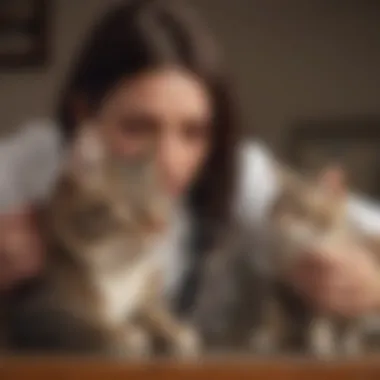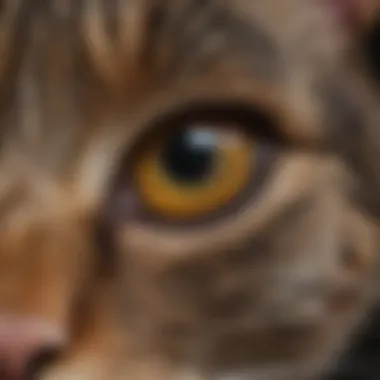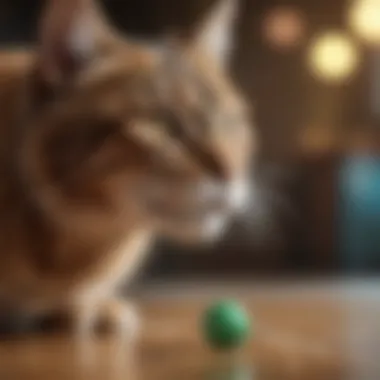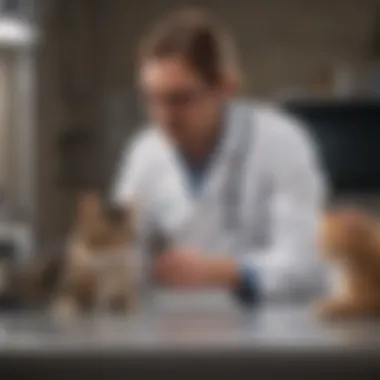Recognizing Health Issues and Symptoms in Cats


Intro
Understanding Your Pet
Breed Traits
Different cat breeds exhibit distinct health traits. For example, Siamese cats are known to develop respiratory issues, while Maine Coons may be prone to hypertrophic cardiomyopathy. Being aware of these traits helps you prepare for potential health challenges associated with specific breeds.
Common Temperaments
Temperament plays a role in a cat's health. A more anxious cat might be at risk for stress-related issues, such as urinary problems or hair loss. Conversely, a calm cat may help maintain a lower stress level in a multi-pet household. Understanding your cat's temperament can aid in monitoring their mental health and overall well-being.
Special Needs
Some cats have special needs that require additional care. Older cats often need modifications in diet and environment due to age-related health issues. Similarly, cats with chronic conditions like diabetes need a structured routine for feeding and medication. Tailoring your approach to your pet's specific needs is fundamental in promoting their health.
Pet Care Essentials
Nutrition and Feeding Guidelines
Proper nutrition is vital for preventing a range of health issues in cats. High-quality cat food, tailored to their life stage, is essential. Ensure you measure portions to avoid obesity, which leads to various health problems. Consult with your veterinarian to select the right food based on your cat's age, weight, and lifestyle.
Grooming Tips and Techniques
Regular grooming not only keeps your cat's coat healthy but also serves as a way to check for any unusual lumps or skin issues. Brush your cat routinely to prevent matting, especially for long-haired breeds. Additionally, routine nail trimming and dental care are often overlooked but essential in preventive health care.
Health and Wellness
Regular veterinary visits are crucial to monitor your cat's health. Vaccinations protect them from various illnesses, and routine check-ups can detect health issues before they become serious. To enhance wellness, consider regular parasite prevention treatments for fleas, ticks, and worms.
Training and Behavior
Basic Training Techniques
Training is not just for dogs. Cats can be trained to use litter boxes, scratch designated areas, and even respond to commands. Positive reinforcement methods, such as treats and praise, work well to motivate cats during training sessions.
Behavioral Problems and Solutions
Behavioral issues in cats can manifest as aggression, anxiety, or litter box avoidance. Understanding the root cause is crucial for addressing these problems. For example, behavioral changes can arise due to stress from environmental changes. Consult with a veterinarian or animal behaviorist for specific behavior management strategies.
Mental Stimulation Activities
Cats require mental stimulation to prevent boredom, which can lead to unhealthy behaviors. Interactive toys, puzzle feeders, and simple games can keep your cat's mind active. Offering a variety of engaging activities helps maintain both their mental and emotional health.
Engaging with Your Pet
Interactive Games and Toys
Engagement is key to a cat's happiness. Invest in interactive toys that encourage play. Wand toys and laser pointers are great for promoting exercise while strengthening your bond with your pet.
Safe Outdoor Activities
If feasible, consider creating a safe outdoor space for your cat. Leash training can also offer a way to safely explore the outdoors under your supervision. Environments like catios provide stimulation without the risks of free roaming.
Family-Friendly Pet Interactions
Introduce your cat to family members with care to establish positive relationships. This is also true for new pets. Supervised interactions allow everyone to acclimatize to each other gradually, reducing stress and promoting a harmonious household.
Pet Adoption and Integration
Choosing the Right Pet for Your Lifestyle
When considering adopting a cat, evaluate which breed suits your lifestyle. Active individuals might prefer playful breeds, while those seeking a more relaxed companion may choose less demanding cats. Matching your lifestyle with a cat's needs is essential for a successful adoption.
Preparing Your Home for a New Pet
Create a peaceful home environment for your new cat. Set up a designated area with food, water, and a litter box. Ensure your home is safe by removing hazards, such as toxic plants and small objects. A prepared space helps ease the transition for both you and your new feline friend.
Tips for Smooth Intro
Introduce a new cat to existing pets slowly. Start with separate spaces, gradually allowing them to meet under supervision. Patience is vital during this acclimatization process. Allow each pet to adjust at their own pace while monitoring interactions to foster positive relationships.
Regular veterinary check-ups are fundamental in maintaining your cat's health. Early detection of health issues often leads to better outcomes.
Recognizing and addressing health problems in cats requires attention and knowledge. By understanding your cat's specific needs and being proactive in care, you can help them lead a healthier and more fulfilling life.
Prelims to Feline Health


Feline health is a critical subject that every cat owner must prioritize. Understanding the nuances of cat health problems can significantly influence a pet's quality of life. As a cat owner, knowing the signs of common ailments can enable timely intervention, which can be a matter of life and death in some cases.
Cats are adept at hiding their pain and discomfort, which can often obscure potential health issues until they become severe. By familiarizing yourself with common health problems and their symptoms, you can play a pivotal role in maintaining your cat's well-being. In this article, we aim to shed light on various facets of feline health, exploring conditions ranging from obesity to dental issues, and offering insights into prevention and management.
Effectively recognizing symptoms can lead to early diagnosis and treatment. This not only fosters a stronger bond between you and your cat, but also enhances your pet's overall health. Furthermore, understanding these health problems encourages responsible pet ownership, contributing positively to the larger community of cat enthusiasts.
The roadmap to feline health in this guide is not just about awareness; it’s about empowerment. Knowledge is a powerful tool that can facilitate better veterinary care and informed decisions regarding your pet’s lifestyle.
Understanding lightens the path to effective health management for your feline friend.
With the right information, you can make educated choices that promote a healthier, happier life for your cat. Each section that follows will delve deeper into specific health issues, helping create a well-rounded perspective on feline health challenges and care strategies.
Common Health Issues in Cats
Understanding common health issues in cats is vital for any pet owner. These issues can often escalate if not addressed in time. Common health problems not only affect the wellbeing of your cat but also impact the relationship you share with them. Early recognition of symptoms can save lives and enhance the quality of life. Therefore, being educated about these concerns is an essential part of responsible pet ownership.
Obesity
Causes of Obesity
Obesity in cats is primarily caused by an imbalance in calorie intake and energy expenditure. Many pet owners unknowingly contribute to their cat's obesity by overfeeding or providing high-calorie treats. Additionally, sedentary lifestyles further exacerbate the issue. This section is crucial as it highlights the importance of monitoring your cat's diet and activity levels to maintain a healthy weight. It will also point out the key characteristic of obesity as preventable through education and behavior change.
Recognizing Symptoms
Recognizing symptoms of obesity is important for early intervention. Common signs include difficulty in grooming, decreased activity, and visible excessive weight. When pet owners are aware of these indicators, they can take proactive measures. This part of the article makes it clear that early recognition leads to prompt action, which benefits both the cat's health and the owner's peace of mind.
Impact on Health
The impact of obesity on a cat's health is far-reaching. It can lead to diabetes, arthritis, and heart diseases. Understanding this relationship emphasizes the severity of the issue. Addressing obesity early can prevent these severe health problems from developing later in life, ultimately improving your cat’s overall wellbeing.
Dental Problems
Types of Dental Issues
Dental health is often overlooked in cats. Common issues include periodontal disease, gingivitis, and tooth decay. By educating pet owners on these types, the article underscores the necessity of regular dental care. Recognizing the types of dental issues is beneficial because it helps owners take preventative measures before severe issues arise.
Symptoms to Watch For
Some symptoms indicating dental problems include bad breath, difficulty eating, and visible tartar build-up. Identifying these signs early allows for timely vet visits. This section provides valuable insight into the owner's role in monitoring their cat's dental health. Early intervention can prevent pain and discomfort for the cat.
Treatment Options
Treatment options range from professional dental cleaning to extractions. This section highlights that various interventions exist based on the severity of the issue. Knowing these options allows owners to take informed decisions about their cat's dental care. Proper dental treatment can enhance a cat’s quality of life by alleviating pain and discomfort.
Kidney Disease
What is Kidney Disease?
Kidney disease in cats is a common ailment that usually affects older cats. This section focuses on explaining how the kidneys work and what dysfunction means for a cat's health. Understanding kidney disease helps owners recognize its importance and the need for regular check-ups as cats age.
Early Symptoms
Subtle signs such as increased thirst and urination can suggest kidney problems. Recognizing these early symptoms is vital. Early detection can lead to better management and prolonged life for affected cats. This knowledge empowers pet owners to act swiftly in consulting a veterinarian for further evaluation.
Long-term Management
Long-term management for kidney disease may include dietary changes and medication. Owners play a crucial role in managing their pet’s diet. This section elaborates on how consistent monitoring can impact the longevity and quality of life for cats with kidney issues.
Diabetes
Understanding Feline Diabetes
Feline diabetes is characterized by elevated blood sugar levels and insulin resistance. This section will clarify the causes and the different types of diabetes that can affect cats. Understanding this condition is important as it demystifies potential fears surrounding the diagnosis.
Signs of Diabetes
Common signs include excessive thirst, increased urination, and weight loss despite a good appetite. Recognizing these symptoms early can lead to prompt treatment. This knowledge is crucial in ensuring that otherwise healthy cats do not face unnecessary suffering.
Management Strategies
Management strategies may involve insulin injections and diet modifications. Pet owners can learn how to effectively manage their cat’s diabetes and maintain stability. Understanding the process and importance of compliant care helps empower cat owners to provide better health for their pets.
Thyroid Issues
Hypothyroidism vs.
Hyperthyroidism Hypothyroidism is less common in cats than hyperthyroidism, which involves an overproduction of thyroid hormone. It is vital to educate pet owners on the differences. Knowing whether a cat is more likely to suffer from one or the other helps in monitoring their health effectively.
Recognizing Symptoms


Weight loss, increased appetite, and hyperactivity can signal hyperthyroidism. Conversely, lethargy and weight gain can suggest hypothyroidism. Recognizing these symptoms greatly enhances the likelihood of early diagnosis, thereby improving treatment outcomes.
Available Treatments
Treatment options may include medication, diet changes, or surgery. This section discusses the range of treatments available, helping owners understand their choices. Being informed allows for better decision-making regarding their cat's health management.
Parasites
Types of Parasites
Common parasites affecting cats include fleas, ticks, and worms. This section focuses on classifying and understanding various parasites. Being aware of these common intruders raises awareness among cat owners to maintain preventative measures.
Symptoms of Infestation
Symptoms can include itching, weight loss, and digestive issues. Recognizing the signs of infestation allows for quicker remedial action. This knowledge empowers owners by giving them specific observations to report to their veterinarians.
Preventive Measures
Preventive measures such as regular deworming and flea treatments are essential. This section highlights the preventive steps owners can take to manage parasite threats. Knowing how to protect their pets from parasites aids in maintaining their overall health and comfort.
Heart Disease
Types of Heart Disease
Common kinds include hypertrophic cardiomyopathy and dilated cardiomyopathy. Understanding these types helps in recognizing potential health risks. This comprehension enables earlier intervention, improving health outcomes for afflicted cats.
Symptoms to Note
Symptoms may include lethargy, difficulty breathing, and decreased appetite. Recognizing these signs promptly allows for essential clinical evaluation. This knowledge is imperative for pet owners to understand the implications of heart disease on their cat's health.
Diagnostic Tools
Diagnostic tools like echocardiograms and X-rays are essential in determining heart disease. A thorough understanding of these tools empowers cat owners to inquire and engage during veterinary visits. Having reliable information on diagnostic techniques ensures informed discussions about their cat’s health.
Infections
Common Types of Infections
Cats can suffer from various infections, including upper respiratory infections and urinary tract infections. Identifying common infections leads to enhanced awareness. This will prepare owners for recognizing and addressing these issues effectively.
Symptoms Indicating Infection
Fever, coughing, and lethargy can hint at an underlying infection. By noting these signs, owners can act quickly. Early intervention through veterinary care is crucial for managing infections effectively.
Treatment Protocols
Treatment protocols vary by infection type but often include antibiotics or antiviral medications. Knowledge of these treatment options is vital for owners. Being informed enhances the ability to follow through with prescribed therapies, ensuring a speedy recovery for the cat.
Symptoms of Illness in Cats
Understanding the symptoms of illness in cats is essential for pet owners. Cats often hide their discomfort, which makes recognizing health issues challenging. Being aware of these symptoms can prompt timely veterinary visits, which is crucial for early diagnosis and treatment. By identifying changes in physical conditions, behaviors, or appetite, owners can ensure their cats receive proper care before issues escalate.
Physical Symptoms
Changes in Weight
Changes in weight in cats, whether loss or gain, can indicate underlying health issues. Weight loss may suggest metabolic problems, while weight gain often points to dietary issues or lack of exercise. Monitoring your cat's weight is a practical step. A sudden change can warrant an immediate check-up. It reveals significant metabolic and lifestyle shifts that are essential for overall health management.
Coat Condition
A cat’s coat condition is often a reflection of its internal health. A dull or unkempt coat may signal nutritional deficiencies or illness. Regular grooming allows owners to observe these changes closely. A healthy coat is typically shiny and smooth. Noticing alterations can lead to early intervention. Maintaining a proper grooming routine can enhance both appearance and overall health.
Behavioral Changes
Behavioral changes in cats are sometimes more telling than physical symptoms. Increased aggression, excessive hiding, or unusual vocalization can denote stress, pain, or illness. Understanding each cat's baseline behavior is crucial. Noting deviations can prompt owners to investigate potential health problems, leading to timely veterinary assessments.
Gastrointestinal Symptoms
Vomiting and Diarrhea
Vomiting and diarrhea are common gastrointestinal symptoms that should not be ignored. They can result from various causes including dietary changes or infections. Persistent vomiting or diarrhea can lead to dehydration and other serious issues. Monitoring these symptoms can enable early treatment, which is vital for recovery. Observing the frequency and severity is crucial for veterinary consultations.
Appetite Changes
Changes in appetite can signify potential health problems. Increased hunger might suggest diabetes, while a sudden lack of interest in food could indicate dental issues or gastrointestinal disorders. Keeping a diary of these changes aids in discussions with veterinarians. Noticing these shifts can help in ensuring that your cat receives adequate care promptly.
Signs of Pain
Signs of pain in cats can be subtle. Symptoms may include reluctance to move, changes in grooming, or unusual vocalizations. Recognizing these signs requires keen observation and understanding of normal feline behavior. Identifying pain early can lead to better management solutions, resulting in improved quality of life for the cat.


Respiratory Symptoms
Coughing and Sneezing
Coughing and sneezing may each indicate underlying respiratory issues. These symptoms can arise from allergies, infections, or other diseases. Monitoring the frequency and context can provide useful information for a vet consultation. Understanding these signs can help in discovering chronic conditions early, which can greatly benefit treatment.
Labored Breathing
Labored breathing is a concerning symptom that may indicate serious health problems, such as heart disease or pneumonia. Observing changes in breathing patterns is essential. If your cat exhibits signs of difficulty breathing, it is an emergency requiring immediate veterinary attention. Prompt action can be life-saving.
Nasal Discharge
Nasal discharge can arise from various causes, including infections or allergies. Clear or colored discharge can suggest different issues. Keeping track of these signs becomes significant in diagnosing viral or bacterial infections. It’s beneficial to seek veterinary advice if nasal discharge persists, as it may indicate underlying health problems needing treatment.
Behavioral Indications
Aggression and Hiding
Aggression or hiding can signal distress or discomfort in cats. Such changes might be related to pain, anxiety, or environmental factors. By identifying these patterns, owners can take steps to alleviate discomfort, possibly improving the cat’s condition. Monitoring these behaviors can provide insight into a cat’s mental and emotional welfare.
Changes in Grooming Habits
Changes in grooming habits can indicate illness or psychological distress in cats. Over-grooming may suggest anxiety or skin irritations, while lack of grooming can indicate health problems such as obesity or pain. Observing these habits closely is essential. Timely identification can lead to appropriate interventions.
Altered Social Interactions
Altered social interactions require attention. A cat that typically enjoys socialization but suddenly withdraws may be experiencing health issues. Alternatively, increased aggression towards other pets may indicate pain or discomfort. Observing these changes can prompt examination or vet consultations, enhancing the likelihood of proactive care.
Recognizing symptoms early can significantly improve the life of your cat. Always consult a veterinarian if you notice concerning changes.
Preventative Health Care
Preventative health care is a critical aspect of maintaining cats' overall wellness. It involves various strategies aimed at preventing health issues before they arise. The most important element of preventative care is regular identification of risks and taking proactive steps to address them. This approach not only helps prolong the lives of cats but also enhances their quality of life. Preventative measures can ultimately reduce the costs and stress associated with unexpected illnesses.
Regular Veterinary Visits
Importance of Check-ups
Regular veterinary visits are paramount in ensuring your cat remains healthy. Check-ups allow veterinarians to detect potential health issues early. Early detection often leads to better outcomes and simpler treatment. It is advantageous as it creates a consistent medical history and allows for monitoring of any changes in health. Additionally, frequent visits help in establishing a good relationship between the pet and the vet, which can ease anxiety for both parties during examinations.
Vaccination Schedule
A proper vaccination schedule is essential for preventing various diseases in cats. Vaccines protect against serious conditions such as feline distemper, rabies, and upper respiratory infections. Keeping a strict vaccination timeline helps ensure your cat is not exposed to transmissible dangers. The crucial benefit is that it helps in providing immunity, establishing a health safety net for your pet. Early on, it could save your cat's life, so adhering to schedule is very important.
Routine Blood Work
Routine blood work is another key component of preventative health care. Blood tests can provide insights into your cat's organ function, hydration levels, and potential underlying conditions that may not be evident during a physical exam. Understanding these markers contributes to overall health management and intervention strategies. Regular blood work is advantageous as it helps catch early signs of common diseases, such as kidney or liver dysfunction. This type of monitoring can guide health strategies throughout the cat's life.
Nutrition and Weight Management
Understanding Cat Nutrition
Understanding cat nutrition is vital to ensuring optimal health. Cats have unique dietary needs compared to other pets. Proper nutrition plays a significant role in preventing health issues such as obesity and diabetes. Recognizing the right balance of proteins, fats, and carbohydrates will contribute significantly to a cat's longevity. Nutritional knowledge allows pet owners to make informed choices about cat food and feeding practices to enhance well-being.
Portion Control
Portion control is integral to managing a cat's weight. Overfeeding can lead to obesity, which is linked to numerous health problems, including diabetes and joint issues. Maintaining the right portion size encourages a healthy weight and prevents unnecessary health risks. It is important to follow feeding guidelines provided by vets or on food packaging. Effective portion control leads to a more active and healthier pet.
Weight Maintenance Strategies
Weight maintenance strategies involve more than just diet; it encompasses regular exercise and engagement. Physical activity is vital for maintaining a healthy lifestyle for cats. Engaging in activities such as play sessions can aid in weight management and reduce the risk of obesity-related diseases. Weight maintenance strategies create a balanced lifestyle which is essential for long-term health.
Mental and Physical Stimulation
Engaging Play Ideas
Engaging play ideas are crucial for keeping cats mentally and physically active. Active play promotes better behavior and reduces stress. Various toys and activities can stimulate your cat's instinct to hunt and play. Regular interaction through play helps to avoid boredom and associated negative behaviors such as scratching or aggression. Incorporating games leads to a fulfilling and stimulating environment that helps your cat thrive.
Environmental Enrichment
Environmental enrichment is about creating a stimulating environment for your cat. This includes providing scratching posts, climbing structures, and interactive toys. Enrichment activities can prevent behavioral problems by satisfying a cat’s natural instincts. By enhancing the living space, you provide mental challenges that lead to happier and healthier pets. The diversity in their environment can substantially improve their psychological well-being.
Social Interaction Importance
Finally, social interaction plays a significant role in a cat's mental health. Cats are social creatures, and they benefit from interactions with humans and other pets. Regular socialization can enhance a cat’s well-being, reducing anxiety and stress. Building a close bond with your pet encourages better behavior and emotional health. This aspect is indispensable for fostering a trusting relationship between the cat and owner.
Epilogue
From discussing common health issues such as obesity, dental problems, and kidney disease to symptoms that manifest in physical, gastrointestinal, and behavioral ways, a thorough understanding enables pet owners to take proactive measures. Early detection can significantly influence treatment outcomes and improve the quality of life for pets.
The health of a cat is also intimately linked to preventative care. Regular veterinary visits ensure that vaccination schedules are kept and any potential health concerns are addressed promptly. Nutrition, weight management, and mental stimulation contribute to a cat's physical and emotional health.
"Prevention is always better than cure."
For pet owners and prospective adopters, this information is invaluable. It empowers individuals with the agency to act when health issues arise. Recognizing that a cat’s behavioral changes or physical symptoms may indicate serious health problems can prompt timely interactions with veterinary professionals.



